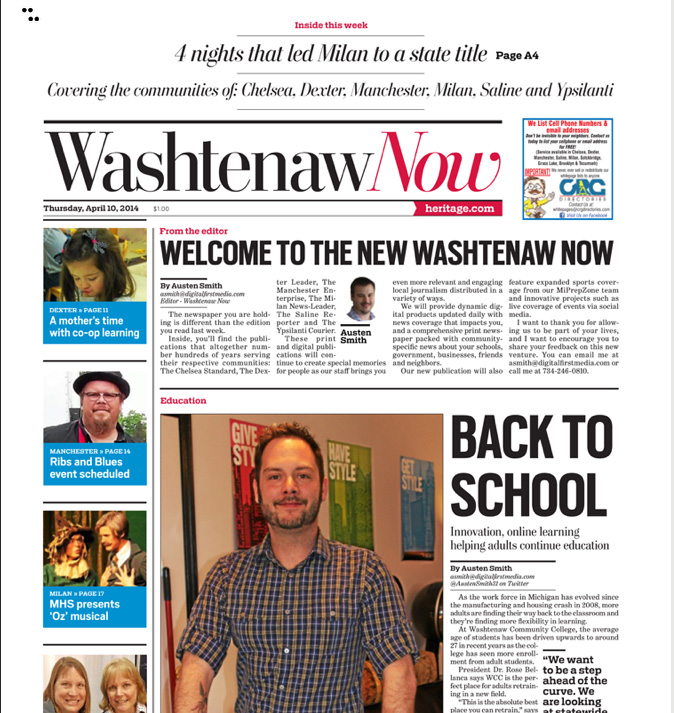by P.D. Lesko
Please note: This piece was corrected to reflect the fact that the A2 Journal published on Thursdays only. We apologize for the error.
IN 2009, AFTER Advance Publications shuttered the former Ann Arbor News, Heritage Media moved into the Ann Arbor marketplace with a new publication titled the A2 Journal. A newspaper published on Thursday and Sunday, the A2 Journal, like the online news site AnnArbor.com, was an experiment. A failed experiment, as it turned out. Just months after AnnArbor.com was shuttered and re-rebranded as the Ann Arbor News, the A2 Journal was shuttered.

In April, Heritage announced that it was launching Washtenaw Now, a cross-market tabloid which consolidates coverage of multiple towns, such as Dexter, Saline and Chelsea, within a single publication.
In 2009, editor Michelle Rogers posted this to the then newly-launched A2 Journal blog:
Heritage Newspapers will soon launch A2 Journal, a free weekly newspaper focusing on Ann Arbor, and this is our first official blog post. I thought I would post something in advance of publication to keep readers informed about what we’re up to since we already have a lot of followers on Twitter asking questions and wishing us the best.
The new publication will be a home-delivered community newspaper covering what makes Ann Arbor unique, and will be distributed to 20,000 households in the Ann Arbor School District area beginning July 9.
In addition to myself as editor, A2 Journal’s staff will include Terry Jacoby as assistant editor, Don Richter as sports editor, Lisa Allmendinger as staff reporter and Mike Larson as sports reporter.
Rogers and Jacoby, are now gone from Heritage. Lisa Allmendinger, a popular Ann Arbor News writer, eventually left the A2 Journal to launch her own news cottage industry with an online news site called Chelsea Update.
Michelle Rogers oversaw seven Heritage newspapers published in communities surrounding Ann Arbor. The A2 Journal was a part of the Journal Register Co., which owns 20 daily newspapers and 159 non-daily publications.
Just months before the launch of the A2 Journal, the Journal Register Company filed for Chapter 11 protection from its creditors and blamed slumping advertising revenue and circulation.
In court documents filed in U.S. Bankruptcy Court in Manhattan, company Chairman and Chief Executive James W. Hall said the recession had placed an even greater burden on an already distressed industry.
In 2009, the Yardley, Pa.-based newspaper publisher reported $596 million in assets as of Nov. 30 and $692 million in debt, including unpaid interest. Revenue had fallen more than 20 percent since 2006, the company said in the court filing.
Prior to its Chapter 11 filing, the company employed 3,500 people. A month after the launch of the A2 Journal, its parent company emerged from Chapter 11 protection and the changes started coming quickly. John Paton was hired as CEO, and he committed to growing digital revenue. He experimented with open-source software and open-to-the-community newsrooms.
Through it all, Paton emerged as the media industry’s most vocal cheerleader for a digital-first culture — and that was even before “digital first” went from a mantra to the name of a new parent company that would also run the much larger MediaNews chain of newspapers. JRC reported digital revenue growth as strong or stronger than their peers and seemed to be making good progress.
JRC was purchased by Alden Global Capital, a hedge fund that has investments across much of the publicly traded U.S. newspaper industry. Alden, as a fund, focuses on distressed assets, those available at market values below their true value. It was this change in ownership, more than the company’s financial woes, that contributed to the eventual decision to close the A2 Journal and launch Washtenaw Now.
John Paton, in his bid to increase revenues, rebranded JRC as Digital First Media (DFM) and created a 50-plus person, New York City-based operation in December 2012. Paton called the new operation Project Thunderdome. According to the Project’s website: “Thunderdome is Digital First Media’s solution to providing content, support and coordination to its network of more than 100 local newsrooms, each with their own distinct communities and stories. Think of it as the wire service local newsrooms wish they had.
“Based on the strength of this network, Thunderdome is able to leverage the most-engaging news reports of the day – produced by DFM journalists and through a growing portfolio of media partners – for publication and distribution on all platforms.”
Alden Global Capital grew tired of consistent print advertising loses and demanded that JRC/DFM implement upwards of $100 million in cuts. Closing Thunderdome was just part of that cost cutting initiative. Industry experts predict that Alden Global Capital is readying its newspaper properties for sale. They’re not yet on the market, but analysts expect regional auctions of DFM properties (with clusters around the Los Angeles area, the Bay Area, New England, Colorado, Texas, New Mexico and Pennsylvania) — unless Alden can find a single buyer, which is unlikely.
The reason for the sale: Despite CEO John Paton’s aggressive remaking of the company, Alden’s investments in cheap newspaper company shares haven’t worked out the way private equity bets are supposed to.
This is sad news for residents of Chelsea, Dexter and Ypsilanti who’ve lost their stand alone weekly newspapers. In Ann Arbor, the loss of the A2 Journal leaves The Ann Arbor Independent, an independently-owned weekly newspaper, in a marketplace that has been dominated by New York media conglomerate Advance.
As for Michelle Rogers, she recently donated a kidney to her boyfriend’s sister, Nancy Noble. Rogers went back to work 19 days after the surgery only to decide that after 22 years working for the Heritage Newspaper group it was time to move on to her next great adventure in journalism.


@Ponette, thank you for pointing out that mistake. It has been corrected and noted.
A2Journal came out once a week. It never published on Sundays.